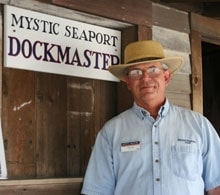
RNMystic220
Each time a cruising sailboat eases into a slip or ties up alongside a bulkhead at Mystic Seaport, in Mystic, Connecticut (www.mysticseaport.org), it helps spread the message that the story of America’s maritime past is also the story of America’s founding as a nation.
By paying fees to make landfall at the leading maritime seaport in the United States, each visiting boat helps secure the future of Mystic, which is in the midst of an ambitious campaign to boost its public image and reverse a downward trend in membership, attendance, and revenues.
So I discover on a recent visit, albeit by car. “This is an outdoor living history museum,” says staffer Michael O’Farrell. “We’re focusing on three aspects of our mission: education, the museum, and as a destination attraction.”
The Seaport, he explains, which has its origins in the Greenman Brothers family shipyard of the 19th century, is a nonprofit organization that functions in several dimensions. Those include the Henry B. duPont Preservation Shipyard, which is devoted to the maintenance, preservation, and restoration of the Seaport’s 500 vessels; the coastal village, which includes a schoolhouse, church, homes, stores, and workshops that were typical of a seaside shipbuilding community in the 1800s; and the north end of the seaport, which houses formal permanent and rotating exhibits as well as an arts activity center for children, called the “Art Spot.”
The Seaport fulfills its educational mission through an array of learning platforms catered to specific ages, from toddler to university level and adult extra-curricular. At the boathouse, you can rent rowboats and small sailboats. Or you can join the community sailing program and learn to sail aboard Dyer Dhows. Demonstrations of furling sails and cargo handling take place aboard the Charles W. Morgan, America’s oldest wooden whaler. Programs will help you learn knot tying, scrimshaw, blacksmithing, and boatbuilding. Or take a course held by the American Boat and Yacht Council-all of this barely scratches the surface of what’s available. Consult the Seaport’s course catalog for a complete list of classes.
To pull off the “living” aspect of its history mission, the Seaport has undertaken several improvement projects at the shipyard so it can take on more boat refurbishment. The lift dock has been rebuilt, and the permanently installed Morgan’s being refit at a cost of $3.5 million. Its hull will be strengthened with some of the 200 tons of live oak the Seaport imported from coastal Mississippi after Hurricane Katrina.
On this tour, my living history lesson arrives when I feel the heat from the coal-fired steam engine aboard the S.S. Sabino, one of the last passenger vessels of her kind and a U.S. Historic Landmark. The Seaport, which acquired the boat in 1973 and refit her from her days on the Damariscotta River in Maine, offers daytime and evening cruises and charters. (For fee and schedules call 860-572-5351.)
Aside from membership, visitors, its educational programs and Sabino cruises, the Seaport makes money from a winter lecture series, special events such as the wintertime lantern tours, the bookstore, a day camp program, as well as a partnership with the nearby Mystic Aquarium and Institute for Exploration. The Seaport is used for location shoots for weddings, fashion photography, television, and film. It also operates from a $50 million endowment fund, O’Farrell says.
When sailors make landfall at the Seaport aboard their own boats, it’s a win-win situation for both parties-docking fees are also an important source of Mystic’s annual operating budget. Visiting sailors, whether they’re members or not, immediately gain free admission to the countless exhibits, programs, and displays throughout the 17-acre waterfront property, as well as free shuttle service within the Seaport and water taxi service (for a charge) into downtown Mystic.
Other cruising amenities include heads and showers, a laundry, 110-volt electricity as well as limited 220-volt outlets, ice service, recycling and trash receptacles, pumpout facility, and a lounge for relaxing, having a cup of coffee, or surfing the web. There’s a dinghy dock, and sailors who can’t or don’t dock at the Seaport are welcome to tie up there.
The seaport can handle up to about 40 boats along its long bulkhead and in its 12 slips, though it can actually accommodate up to about 100 boats if they’re rafted up flotilla-style. Depth ranges from 10 to 12 feet, and there’s a small anchorage in soft mud that can handle up to four or five boats in the north end of seaport waters.
There’s a tiered rate structure-in the 2007 summer season, nonmembers pay $3.75 a foot and members pay $2.75 a foot. Members also enjoy a host of extra benefits, such as free dockage October 15 through April 30, discount passes for guests, a subscription to Mystic Seaport magazine and WindRose. Members also are entitled to fly the Mystic Seaport burgee, the house flag of the Morgan.
And then there are the intangibles. “There’s nothing better than getting up early and wandering around here before the Seaport opens,” dockmaster Dick Lotz tells me. Each season, which runs May 1 to November 1, about 1,300 boats stay at the Seaport, he adds, so reserve by the end of April if you think Mystic will be a part of your itinerary. On May 1, all reservations are taken by phone and deposits are required. For details contact Lotz (860-572-5391).







